Menus
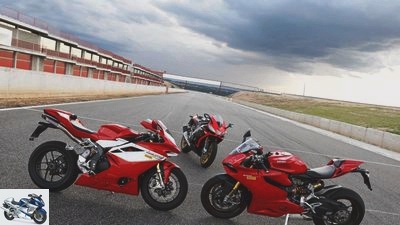
Jahn
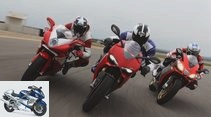
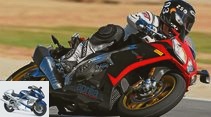
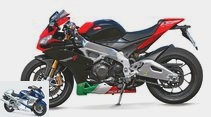
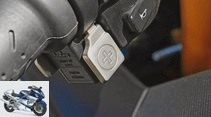
22nd photos
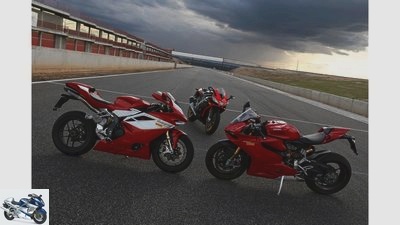
Jahn
1/22
Three Italian super athletes in a comparison test. MV Agusta F4 RR Corsacorte, Aprilia RSV4 Factory APRC and Ducati 1199 Panigale S..
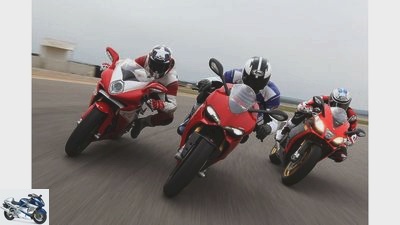
Jahn
2/22
MV Agusta F4 RR Corsacorte, Ducati 1199 Panigale S and Aprilia RSV4 Factory APRC.
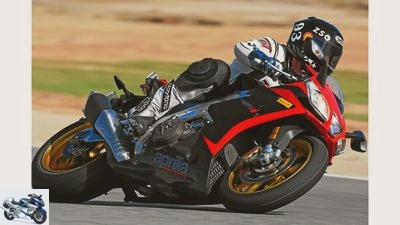
Jahn
3/22
Aprilia RSV4 Factory APRC.
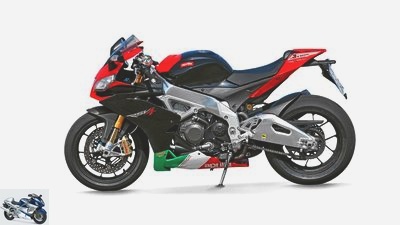
Jahn
4/22
Aprilia RSV4 Factory APRC.
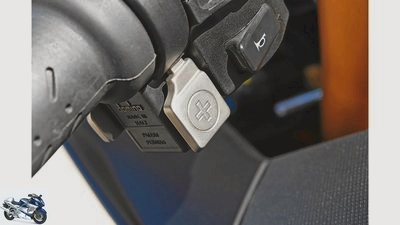
Jahn
5/22
Aprilia: The large buttons are easy to use – sometimes too good and you unintentionally adjust the TC.
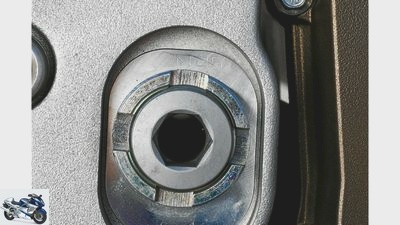
Jahn
6/22
Aprilia: Hardly anyone uses the height-adjustable pivot point.
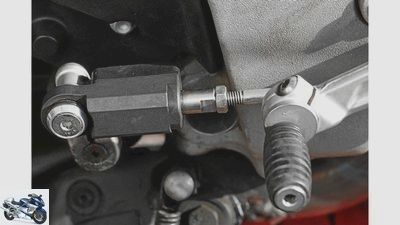
Jahn
7/22
Aprilia: The best gearshift in the test looks exactly like this.
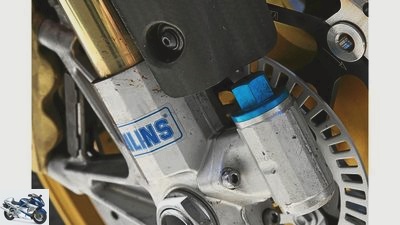
Jahn
8/22
Aprilia: You can see the compression valve well, but it is difficult to get to it.
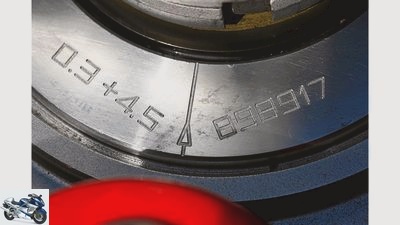
Jahn
9/22
Aprilia: Inlay on the steering head of the RSV to change the steering head angle.
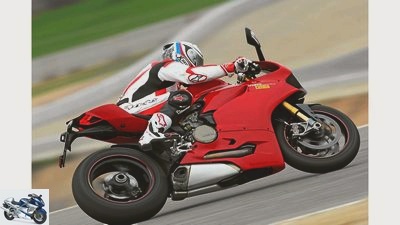
Jahn
10/22
Ducati 1199 Panigale S..
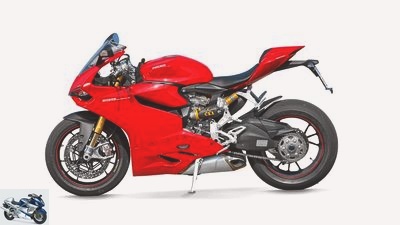
Jahn
11/22
Ducati 1199 Panigale S..
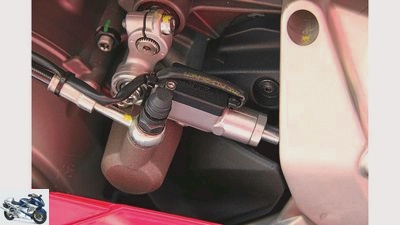
Jahn
12/22
The second best shift assistant. Gear changes only work better on the Aprilia.
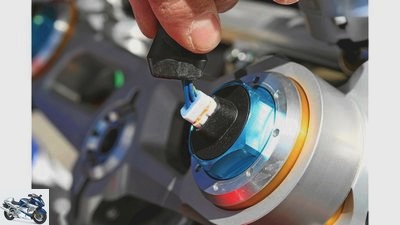
Jahn
13/22
Ducati: Stupid – to change the spring preload you have to pull out the DES connector.
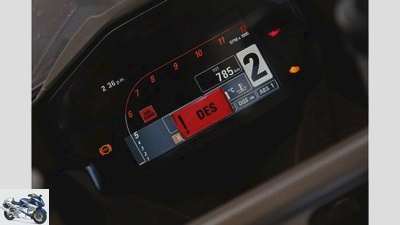
Jahn
14/22
Ducati: Good – error display in the cockpit if the DES connector is not properly seated.
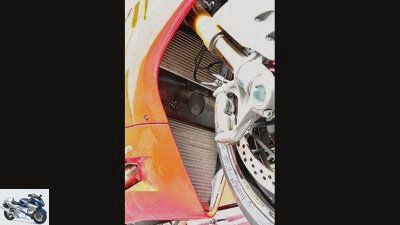
Jahn
15/22
Two water coolers prevent the thermal exitus of the short-stroke Ducati twin.
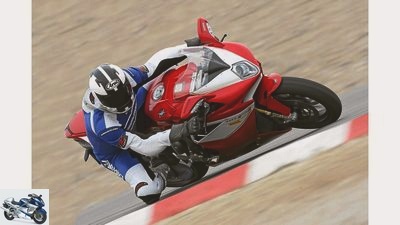
Jahn
16/22
MV Agusta F4 RR Corsacorte.
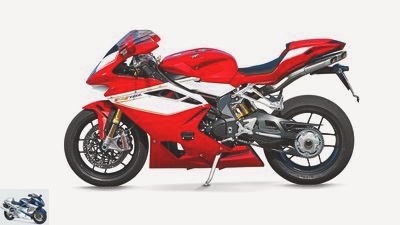
Jahn
17/22
MV Agusta F4 RR Corsacorte.
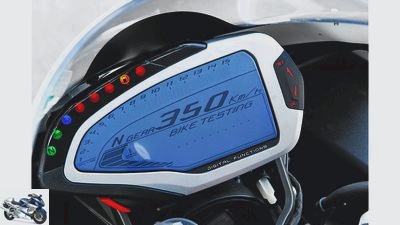
Jahn
18/22
MV Agusta: The cockpit knows what we prefer to do on the race.
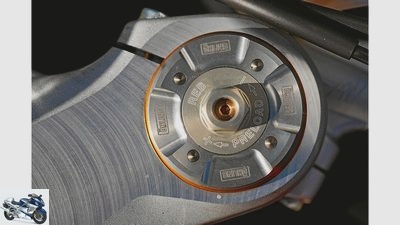
Jahn
19/22
MV Agusta: Everything from above. The compression and rebound stages sit separately in a fork leg
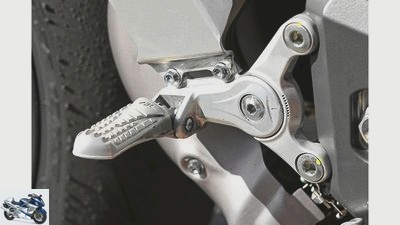
Jahn
20/22
Adjustable but unfortunately quite slippery pegs on the F4 RR Corsacorte.
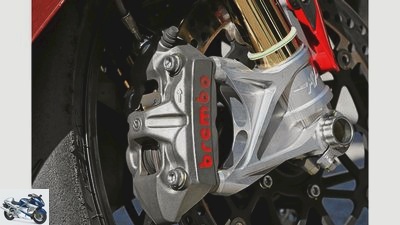
Jahn
21/22
Bold and very effective Brembo monoblocks on the milled MV fork base.
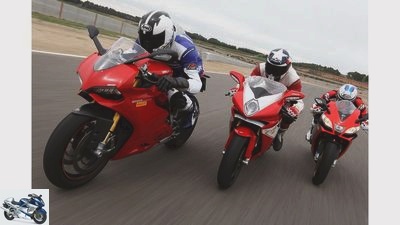
Jahn
22/22
Ducati 1199 Panigale S, MV Agusta F4 RR Corsacorte and Aprilia RSV4 Factory APRC. The Aprilia wins the Italian group test in the end.
Comparison test: Italian superbikes 2012
Super athletes from MV Agusta, Aprilia and Ducati
Content of
The clouds are dark in the sky, and there is a dull rumble and thunder. End of the world or storm? No, the summit of three divine Italian superbikes.
A purely Italian superbike happening is always something very special. It’s about fame and honor, pride and respect, cheesiness and macho behavior – and attention to detail. PS juxtaposes the established duelers Aprilia RSV4 Factory APRC and MV Agusta F4 RR Corsacorte with the Ducati 1199 Panigale S, which swings boldly in Fede gloves. Does that leave the time for romantic moments in love and dolce vita or is it about to hit the road? According to the Mad Max “Thunderdome” motto: three go out – one comes in?
Admittedly, it is difficult not to immediately hop on one of the three Italo rockets and really accelerate. But the eye also wants to enjoy and so you quickly get stuck on one of the many elaborate details of one of the graces. On the Aprilia, in addition to the incredibly delicate rear end that towers high above the fat 200 rear tire, it is above all the technical highlights. The inlays in the frame testify to the changeable motor position in the chassis or the use in the steering head of the adjustable steering head angle. Paradoxically, both equipment features that look important, but have certainly not yet been touched by any hobby racer. In contrast to the electronic equipment in the form of traction control, launch control, the automatic gearshift or the various mappings of the injection system. Still surprising again and again, and this, although the V4-Mille has been milling through the country for some time, is its super-compact design. The RSV is small and petite, almost vulnerable. Up until now, this property has instinctively provided protection for species, because you are not allowed to mess around with “little ones”.
This is ending now! The D.The ucati 1199 Panigale S is of comparable compact dimensions – also with the most delicate rear over the fattest rear tires. However, the overall design of the Duc is kept much more aggressive, especially in the front area, which gives it the evil aura when standing. Their LED lights are eye-catching, as are the large nostrils below the headlights. The beautifully drawn side stand, the Brembo M50 stoppers, which are currently still available exclusively for the Panigale, or the filigree levering of the deflection between the swing arm and the shock absorber, the eye of the beholder is caught everywhere. Speaking of deflection and side-mounted strut: an 1199 Panigale should never fall on the left side of the vehicle. Because everything that is clearly visible will be damaged in the worst-case scenario. And that becomes expensive.
Buy complete article
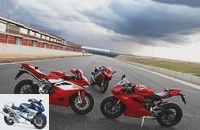
Comparison test: Italian superbikes 2012
Super athletes from MV Agusta, Aprilia and Ducati
MV Agusta F4 RR Corsacorte looks like a dinosaur towards her two colleagues. She’s tall and wide, with a big butt and an underseat exhaust system that has clearly gone out of style. She gives the impression of an aging supermodel. A Linda Evangelista or Cindy Crawford, for example, who still have a unique appearance, but have matured this with increasing age.
Subscribe to MOTORRAD videos on Youtube
So it is then 215 kilograms that the Corsacorte brings on the scales. After all, eleven kilos more than the Aprilia and a full twenty kilos more than the Ducati! But the F4 RR shines as usual with lovely details such as the pretty and adjustable, but smooth footrests, the MV-Logi on the fork feet or its single-sided swing arm and the forged wheels. She is undisputedly a child of the last millennium.
And that’s what it sounds like. Paradoxically, the MV Agusta is not only the oldest motorcycle in the line-up of Italian superbikes, but also the quietest. This fact is due to the valve systems in the intake and exhaust tracts of Aprilia and Ducati. These briefly ensure quiet in the measuring areas checked during the homologation and thus the approval, but unleash an incredible noise outside of this small measuring window! Yes, PS complains about the hardly insulated noise with which Aprilia, Ducati or even a BMW S 1000 RR rushed through the country at high revs. Please don’t be surprised when annoyed residents scream for road closures on streets that are heavily frequented by motorcyclists!
Jahn
MV Agusta F4 RR Corsacorte.
MV Agusta
Speaking of the road closures: The tire warmers have been on the Pirellis for over an hour and the traffic light at the pit exit is green. Gone is the moralist existence, up on the F4 RR and out on the track. Your optically massive impression is confirmed after just a few meters. It is big and stable and needs to be moved with vigor by strong pilots. In return, it gives you back what you expect from an MV: undoubted cornering stability and unclouded feedback. And that is important, especially in this damned left downhill, which is taken terribly quickly in third gear. To pull through the abundant bumps here requires a big heart and good feedback. This position is therefore predestined for the MV – this is where it shows its strengths to the full. In two, it goes over the blind edge, where the road in the direction of the left curve simply folds away under the front wheel. Wheelies happen automatically, so quickly shift into third gear in the crisp but precise gearbox and race towards the left bend at medium speed and gently pulling on the chain. Shift your weight to the left, put pressure on the left side of the handlebars and iron over the heavy bumps with a lot of taste and little fear.
Great, the MV swallows the waves like nothing, comes up with powerful damping reserves and precisely keeps its track. No doubt about it, stability is something wonderful! Then hard braking in front of an opaque right that wants to be turned in very late. There is only a slight instability on the brakes, the rear end is minimally restless, while the right-hand lean turns smoothly. After the right the tight chicane is waiting for the MV. Hard anchoring again, the brembos bite relentlessly and with good feedback into the 320 discs, while the pilot gets ready for the upcoming show of strength: With a lot of energy, the F4 RR first has to be turned to the left and then quickly to the right. That really costs grains on the Brummer. The F4 RR prefers wide, fast arcs, which also underlines its engine characteristics.
The 1000cc four-cylinder works very sharply. Of course, it already gives a lot of pressure in the middle speed range, but the real kick only comes from 9000 rpm. Unfortunately, the co-ordination of the rough-running and sometimes violently vibrating power plant in the upper speed range is not particularly successful. To put it more clearly: If the hard performance kick sets in at 11,000 rpm, it can even be dangerous in a deep lean angle. The MV is then so impetuous and uncontrollable to the point that it not only buys the guts from amateur pilots, but also from seasoned racing drivers. If the MV engineers can get this unnecessarily hard acceleration under control, then the Corsacorte will also achieve lap times. As it is, however, it is the slowest of all three lap timing pilots. Not only because it gives up its performance so improperly, but also because its alleged traction control does not work.
Jahn
Ducati 1199 Panigale S..
Ducati 1199 S.
A lot can be said about the Ducati, only one thing not: that its traction control wouldn’t work. On the contrary: The very inconspicuous working TC even works extremely well. At first we used level 3, but quickly reduced it to level 2, which enables really fast laps. However, only after a short period of getting used to it, because anyone who switches directly from the MV to the Ducati thinks they are sitting on a moped with a rocket drive. Smoke in all positions and handling like from another planet. Despite their completely different concepts, MV and Ducati have one thing in common: Both have engines that crave speed. The Duc’s twin always wants to be held over 6,000 tours on the race, but it also turns up to just under 11,000 rpm. If the delayed response behavior of the ride-by-wire system was criticized in the last PS edition in the country road test, this point of criticism on the racetrack is irrelevant after the above-mentioned familiarization period – you adjust to it very quickly. The steering behavior on the brakes is exemplary not only for a Ducati, but for a super sports car in general. Especially in the narrow chicane, the 1199 can be pulled wonderfully light-footed and neutrally. With the “EBC” (Engine Brake Control) on display, the line fits right away, and as soon as you accelerate out of the chicane you are looking forward to precisely this passage in the next lap. The Duc scores well at the end of the start-finish straight as well.
The bite and the transparency of their front drag are in a class of their own. The excessively hard “initial bite” that was often criticized on 1098 and 1198 when the brake pads were placed on the discs has disappeared on the 1199. The fork setup is now finally able to cope with the sheer force on the brakes and offers good reserves even with waves and edges in the braking zone. The coordination of the hindquarters is less successful, however. When accelerating harshly from an incline, the Panigale becomes restless, begins to waggle and in an emergency does not calm down over the entire straight. This symptom was already noticeable at the presentation in Abu Dhabi and could not be eliminated during this test either by changing the setup of the strut (damping and strut length) or by changing the deflection. Since the unrest was more or less pronounced among all test drivers, it cannot be related to the driving style of an individual driver.
The ergonomics of the Ducati met with general approval. Compact and assembled, it embeds its driver and is easy to direct. Their wide-swept handlebar halves make them even more agile in narrow passages. When looking at the lap times, there is astonishment. In spite of its brutal engine, despite the sensationally tuned ABS, despite the very well functioning TC and the agile handling, it is only enough for second place. Too little feedback from the rear is a point of criticism of the time burners that is often mentioned, the better predictability at the limit of the Aprilia an attribute that the Ducati still lacks.
Jahn
Aprilia RSV4 Factory APRC.
Aprilia RSV4
Bang, the clap is sitting! The Aprilia RSV4 Factory APRC irons Ducati and MV. Each of the three lap time jockeys drove their fastest laps on it. That is an obvious sign. The Aprilia has now reached a level of maturity that makes it almost inviolable on the racetrack. Everyone is enthusiastic about their handling, their precision and the razor-sharp reaction to the pilot’s input. Even earlier criticisms such as the hard throttle response in “track mode” are a thing of the past. The RSV4 is more of a racing motorcycle than anyone would like, because it leaves the driver with no more excuses. Well, almost none. Because with measured 180 hp, the Aprilia is the weakest bike in the test. But how do the fast lap times come about? Not only the superior driveability of the Aprilia plays a role, but also the route characteristics. Alcarraz is a very narrow course, the start-finish straight is not the longest on the planet. These facts play into the cards of the RSV4 as well as the uneven surface. Ultimately, however, these circumstances underscore the fact that maximum performance is not everything. Of course, the V4 could go a little harder at the top to give the pilot a kick and show that he’s getting closer to the red zone. But all in all, the linear power output, along with the chassis quality, is the decisive point why the Mille is so fast. And that raises the question of whether Ducati’s path, namely to wean a twin from the beefy middle and thus the twin character and instead rely on maximum power in the upper speed range, is the right one.
Time will certainly answer this question, because the Panigale also needs time to mature. Its conception is so radically different that it may take a little longer, but its potential is already clearly there. In stark contrast to the MV Agusta F4 RR. Their best days are over and a new concept is urgently needed despite its remaining qualities.
PS evaluation / judgment
Jahn
Ducati 1199 Panigale S, MV Agusta F4 RR Corsacorte and Aprilia RSV4 Factory APRC. The Aprilia wins the Italian group test in the end.
| Max. Points | Aprilia | Ducati | MV Agusta | drive |
| acceleration | 10 | 9 | 9 | 9 | Draft | 10 | 7th | 6th | 7th |
| Power delivery | 10 | 9 | 8th | 6th | Responsiveness | 10 | 8th | 7th | 5 |
| Load change reaction | 10 | 8th | 8th | 7th | Running culture | 10 | 8th | 7th | 6th |
| Gear actuation | 10 | 9 | 8th | 7th | Gear ratio | 10 | 8th | 8th | 8th |
| Clutch function | 10 | 9 | 8th | 8th | Traction control | 10 | 9 | 9 | 0 |
| Subtotal | 100 | 84 | 78 | 63 | landing gear |
| Driving stability | 10 | 8th | 7th | 9 | Handiness | 10 | 9 | 7th | 5 |
| Cornering stability | 10 | 9 | 8th | 10 | feedback | 10 | 9 | 8th | 10 |
| Suspension tuning in front | 10 | 9 | 9 | 9 | Chassis set-up at the rear | 10 | 9 | 6th | 9 |
| Braking effect | 10 | 9 | 10 | 9 | Brake metering | 10 | 9 | 10 | 9 | Righting moment when braking | 10 | 10 | 9 | 10 |
| ABS function | 10 | – | 10 | – | Subtotal | 100 | 81 | 84 | 80 |
| Everyday life and driving fun | Sitting position | 10 | 8th | 8th | 7th |
| Windbreak | 10 | 7th | 7th | 7th | Furnishing | 10 | 9 | 10 | 7th |
| consumption | 10 | – | – | – | Driving fun | 10 | 10 | 8th | 7th |
| Subtotal | 50 | 34 | 33 | 28 | Total | 250 | 199 | 195 | 171 | placement | 1. | 2. | 3. |
1. Aprilia RSV4 Factory APRC
The mille can hardly be cracked on the racetrack. The sum of their qualities is enormous, especially the chassis and the uncomplicated driving behavior collect a lot of points.
2. Ducati 1199 Panigale S.
The newcomer of the year fails very close to the Aprilia. She still lacks that little bit of maturity to be at the forefront. The Ducati was born with the equipment for the winning bike.
3rd MV Agusta F4 RR Corsacorte
In direct comparison, the only inline four-cylinder in the test looks outdated and clumsy. Unfortunately, the smallest Italian motorcycle manufacturer lacks the resources to consistently further develop the F4.
Jahn
Aprilia RSV4 Factory APRC.
Aprilia RSV4 Factory APRC
drive
Four-cylinder 65-degree V-engine, four valves / cylinder, 132 kW (180 PS) at 12,500 / min *, 115 Nm at 10,000 / min *, 1000 cm³, bore / stroke: 78.0 / 52, 3 mm, compression ratio: 13.0: 1, ignition / injection system, 48 mm throttle valves, mechanically operated multi-disc oil bath anti-hopping clutch, six-speed gearbox, G-Kat, chain, traction control
landing gear
Light alloy bridge frame, steering head angle: 65.5 degrees, caster: 105 mm, wheelbase: 1420 mm, upside-down fork, Ø fork inner tube: 43 mm, adjustable spring base, rebound and compression level. Central spring strut with deflection, adjustable in spring base, rebound and compression. Suspension travel front / rear: 120/130 mm
Wheels and brakes
Forged alloy wheels, 3.50 x 17 / 6.00 x 17, front tires: 120/70 ZR 17, rear: 200/55 ZR 17, test tires: Pirelli Diablo Supercorsa, 320 mm double disc brakes with radially attached four-piston fixed calipers at the front, 220- mm single disc with two-piston fixed caliper at the rear
measurements and weight
Length / width / height: 2050/750/1130 mm *, seat / handlebar height: 845/865 mm, handlebar width: 665 mm, 204 kg fully fueled, v./h .: 51.0 / 49.0%
Rear wheel power in last gear
123 kW (167 PS) at 271 km / h
consumption
Fuel type: Super unleaded. Average test consumption: not determined, tank content 17 liters
Base price
22 590 euros (plus additional costs)
Jahn
Ducati 1199 Panigale S..
Ducati 1199 Panigale S.
drive
Two-cylinder 90-degree V-engine, four valves / cylinder, 143 kW (195 PS) at 10 750 / min *, 132 Nm at 9000 / min *, 1198 cm³, bore / stroke: 112.0 / 60.8 mm, compression ratio: 12.5: 1, ignition / injection system, 67.5 mm throttle valves, hydraulically operated multi-disc oil bath anti-hopping clutch, six-speed gearbox, G-Kat, chain, traction control
landing gear
Load-bearing motor with light metal subframe, steering head angle: 65.5 degrees, caster: 100 mm, wheelbase: 1437 mm, upside-down fork, Ø fork inner tube: 43 mm, adjustable spring base, rebound and compression stage. Central spring strut with deflection, adjustable in spring base, rebound and compression. Suspension travel front / rear: 120/130 mm
Wheels and brakes
Forged light alloy wheels, 3.50 x 17 / 6.00 x 17, front tires: 120/70 ZR 17, rear: 200/55 ZR 17, test tires: Pirelli Diablo Supercorsa, 330 mm double disc brakes with radially attached four-piston fixed calipers at the front, 245- mm single disc with two-piston fixed caliper at the rear, C-ABS
measurements and weight
Length / width / height: 2060/810/1110 mm *, seat / handlebar height: 820/850 mm, handlebar width: 670 mm, 195 kg fully fueled, v./h .: 52.5 / 47.5%
Rear wheel power in last gear
131 kW (178 PS) at 279 km / h
consumption
Fuel type: Super unleaded. Average test consumption: not determined, tank content 17 liters
Base price
24 490 euros (plus additional costs)
Jahn
MV Agusta F4 RR Corsacorte.
MV Agusta F4 RR Corsacorte
drive
Four-cylinder in-line engine, four valves / cylinder, 148 kW (201 HP) at 13,400 / min *, 114 Nm at 9200 / min *, 998 cm³, bore / stroke: 79.0 / 50.9 mm, compression ratio: 13, 4: 1, ignition / injection system, 49 mm throttle valves, hydraulically operated multi-disc oil bath anti-hopping clutch, six-speed gearbox, G-Kat, chain
landing gear
Steel tubular space frame, steering head angle: 66.5 degrees, caster: 100 mm, wheelbase: 1430 mm, upside-down fork, Ø fork inner tube: 43 mm, adjustable in spring base, rebound and compression. Central spring strut with deflection, adjustable in spring base, rebound and compression. Suspension travel front / rear: 120/120 mm
Wheels and brakes
Forged alloy wheels, 3.50 x 17 / 6.00 x 17, front tires: 120/70 ZR 17, rear: 190/55 ZR 17, test tires: Pirelli Diablo Supercorsa, 320 mm double disc brakes with radially attached four-piston fixed calipers at the front, 210- mm single disc with two-piston fixed caliper at the rear
measurements and weight
Length / width / height: 2100/830/1090 mm *, seat / handlebar height: 840/845 mm, handlebar width: 680 mm, 215 kg with a full tank, v./h .: 52.8 / 47.2%
Rear wheel power in last gear
129.5 kW (176 PS) at 271 km / h
consumption
Fuel type: Super unleaded. Average test consumption: not determined, tank content 17 liters
Base price
22,900 euros (plus additional costs)
Related articles
-
Comparison test: Superbikes 2012
32 pictures 1/32 Yamaha YZF-R1, MV Agusta F4 RR, Kawasaki ZX 10-R, BMW S 1000 RR and Honda Fireblade C-ABS in the super sports car …
-
Comparison test: KTM Super Duke R against MV Agusta Brutale 990 R
Comparison test: KTM Super Duke R against MV Agusta Brutale 990 R Sporty naked bikes in the test Content of A feast for the senses: The new MV …
-
Comparison test: super sports cars under 1000 cubic meters from MV Agusta, Ducati and Kawasaki
Jahn 46 pictures Jahn 1/46 Kawasaki ZX-6R 636 Jahn 2/46 But the Evo is not alone in this. All three bikes rock the ring during the test. Jahn 3/46 ……
-
Comparison test: Exclusive Italian superbikes
fact comparison test: Ducati Desmosedici RR against Bimota DB7 Oronero Exclusive Italian superbikes in comparison Contents of Attenzione Signore e …
-
Comparison test: Ducati Diavel, Suzuki B-King and Yamaha Vmax
Jahn comparison test: Power Bikes 2011 Ducati Diavel, Suzuki B-King and Yamaha Vmax Content from Big appearance, powerful sound waves, pressure from all …
-
Comparison test Aprilia RSV4 R APRC and Ducati 1199 Panigale
fact comparison test: Aprilia RSV4 R APRC and Ducati 1199 Panigale The best Italian superbikes in comparison The more expensive versions first – few …
-
Ducati 1199 Panigale S versus KTM RC8 R in comparison test
23 pictures 1/23 The two super sports two-cylinder, KTM RC8 R and Ducati 1199 Panigale S, in a comparison test. You are the…
-
Comparison test: MV Agusta Brutale 1090 RR and Ducati Streetfighter S
fact comparison test: Italian naked bikes, Ducati Streetfighter S, MV Agusta Brutale 1090 RR MV Agusta Brutale 1090 RR and Ducati Streetfighter S …
-
Comparison test: mid-range fun bikes
fact comparison test: Aprilia, Ducati, Kawasaki, KTM mid-range funbikes in comparison Content of games, fun and excitement promises a comparison test …
-
Ducati 999 S and Ducati 1199 Panigale S in comparison test
fact 14 pictures fact 1/14 The rattling through town with the Ducati 999 S is deep in the memory. But honestly, there is the current Ducati …